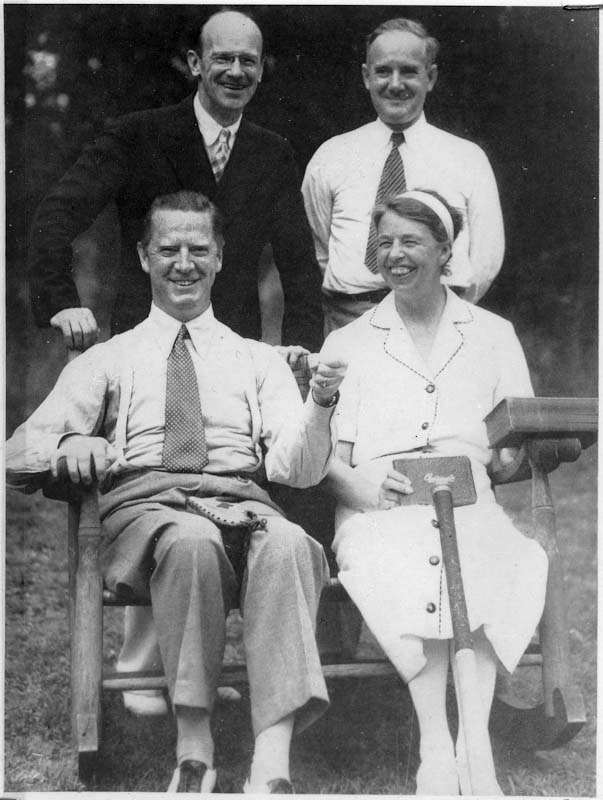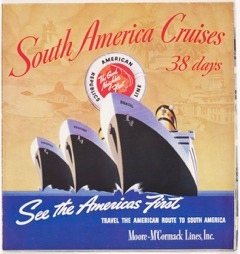Hillary Clinton has a favorite quote from Eleanor Roosevelt: “A woman is like a tea bag. You don’t know how strong she is until she gets into hot water.” With all the criticism of Hillary Clinton these days, let’s remember that Eleanor Roosevelt—who consistently tops polls today as our country’s most-admired First Lady—was a controversial figure in her own day.

Eleanor Roosevelt and Marian Anderson upon arrival in Japan, May 22, 1953.
A friend of mine who is in her nineties remembers the animosity toward Eleanor Roosevelt. She tells of how in 1939 her mother banned her aunt from their home in Philadelphia for two years. The reason? The aunt supported Eleanor Roosevelt’s resignation from the Daughters of the American Revolution in protest of that organization barring Marian Anderson, the internationally renowned contralto and an African-American, from performing in Constitution Hall, which the DAR owned. My friend’s family was one of Philadelphia’s oldest and most distinguished and staunch Republicans.

As a woman who spoke her mind in support of civil rights, labor, and economic dignity for all, Eleanor Roosevelt made many enemies. Some saw her resignation from the DAR as a rebuke to her own heritage—not unlike the charge that FDR was a traitor to his class—and many took it as a personal insult. We all know the outcome of this famous moment in American history, one that is a direct precursor to the civil rights movement of the 1960s. At the suggestion of Walter White of the NAACP, an outdoor concert was proposed on federal property. Eleanor Roosevelt worked with Harold L. Ickes, secretary of the interior and one of the Roosevelt administration’s strongest advocates for equal rights, who arranged a historic Easter Sunday concert for Anderson at the Lincoln Memorial. He introduced her saying, “Genius has no color line.” Attended by 75,000 and broadcast to millions over the radio, the symbolic importance of a black woman singing “My Country, ”Tis of Thee” before the statue of the Great Emancipator was lost on no one. Eleanor Roosevelt did not just earn the ire of the Daughters of the American Revolution. Her usually high poll numbers—yes, they had polls then—dropped by 10%.
Mrs. Roosevelt’s most vocal critic was well-known newspaper columnist Westbrook Pegler. A 1941 Pulitzer Prize-winning journalist, Pegler was syndicated in 174 newspapers six days a week with a readership of ten million at the height of his popularity. His success in uncovering union corruption and his critiques of the New Deal gave him influence on Capitol Hill. A zealous opponent of the New Deal and the 1935 Wagner Act, he was a vocal opponent of both Franklin and Eleanor Roosevelt, but seemed especially vicious toward Eleanor. “I have been accused of rudeness to Mrs. Roosevelt when I only said she was impudent, presumptuous and conspiratorial, and that her withdrawal from public life at this time would be a fine public service.”

First Lady Eleanor Roosevelt watches a baseball game between FDR’s White House Purgers (newspaper correspondents) and broadcaster Lowell Thomas’s Nine Old Men, a benefit baseball team, in 1938. She is seated next to Westbrook Pegler. George T. Bye, her agent (and Pegler’s) is at upper right and music critic and music broadcaster Deems Taylor is upper left. Original caption reads “from program for the benefit of the Boys Club of New York.”
Credit: Franklin D. Roosevelt Presidential Library and Museum. Photo id 52288
Eleanor Roosevelt was a major columnist herself. Her six-day-a-week My Day column had a following of four million readers and was syndicated in 62 newspapers. It was a mixture of folksy news about goings-on in the heady world of the Roosevelts, blended with thinly veiled advocacy for New Deal programs and sometimes pointed commentary on public affairs. A proponent of unionism since the 1920s, she did not hesitate to voice her support for the Wagner Act, which established the legal right of most workers (except agricultural and domestic workers) to organize or join labor unions and bargain collectively with their employers. Bitterly opposed by the business elite and many Republicans, opponents such as the American Liberty League encouraged employers to refuse to comply. A series of violent strikes and allegations of Communist infiltration strained public support. And even after the Wagner Act was declared constitutional in 1937, resistance to unions continued.
Pegler used Eleanor Roosevelt’s membership in the American Newspaper Guild (she was a card-carrying member from 1936 until her death) in his anti-union campaign. He ridiculed her work as a journalist, calling her a “diarist and a dilettante.”
After years of masquerading as a rather naïve but always well-meaning amateur fuss-budget, Mrs. Eleanor Roosevelt lately has been revealing herself as a cunning and indefatigable conspirator against the rights and independence of the individual American citizen and an active proponent of power-government.
Her crime? “ [O]n Thursday she attended a rally of a semi-Communistic Electricians’ Union of the AFL in New York, joined in whooping ‘God Bless America,’ and reiterated the Muscovites’ formula of entrapment which holds that everyone should join a labor organization.”
But Pegler was not her only critic. Eleanor Roosevelt challenged accepted notions of a woman’s “place” and because she had power and did not hesitate to use it, she was a serious threat to the established social order. Her biographer Blanche Wiesen Cook tells us, “There are those who focus on her teeth and voice and other cartoon characteristics, long before they reveal how much they despise her politics, most notably her interest in civil rights, and racial justice, or in civil liberties and world peace.” Cook reminds us that beginning in 1924 (when she worked on behalf of U.S. entry into the League of Nations World Court) and continuing throughout her years in the White House, as a delegate to the United Nations, and ending only in 1961, the year before her death, J. Edgar Hoover kept an FBI file on Eleanor—one of the largest on any individual. Her civil rights activities comprise much of the file and among the allegations investigated was the existence of “Eleanor Clubs,” which were rumored to be organized groups of African-American maids who, under the influence of Eleanor Roosevelt and black leaders, were refusing to work as servants. The charges proved false.
Eleanor’s work to establish Arthurdale, a model community for impoverished out-of-work West Virginia miners, brought heavy criticism since she insisted on quality construction and indoor plumbing for the houses being built. She incurred opposition from business interests when she tried to establish private sector jobs to make the community self-sufficient. As the war began to dilute the nation’s interest in the social legislation of the New Deal, she saw in national defense an opportunity to unify the people and foster a continuing progressive social agenda. FDR agreed and in 1941 issued an Executive Order establishing the Office of Civilian Defense with a broad array of powers designed not only to protect the civilian population, but also to strengthen morale and promote volunteer involvement in national defense.
For a few months, Eleanor Roosevelt eagerly accepted her only official government position, working (without salary) as assistant director of the Office of Civilian Defense. While OCD Director—and New York Mayor—Fiorello LaGuardia focused his attention on preparation for air raids, Roosevelt pushed for “better nutrition, better housing, better day-to-day medical care, better education, better recreation for every age.” The backlash was swift and harsh, as reported in this piece by Mark Sullivan in the New York Times. “Recent developments about O.C.D. have provoked violent criticism. Words and actions of Mrs. Roosevelt have suggested that she would like to use O.C.D. a vehicle for propaganda and organization in behalf of purposes not related to air raids. . . . The answer is up to the President. Won’t Franklin please speak to Eleanor? But a disquieting thought arises—perhaps it is Eleanor who speaks to Franklin.” She resigned soon thereafter.
That she envisioned a better world after the war was controversial. Lynn U. Stambaugh, national commander of the American Legion, charged that Eleanor maligned the veterans of the last war with her statement that “we can’t fight this war unless we are fighting for a changed world.” In response, Stambaugh said, “If Mrs. Roosevelt thinks that America is fighting this war for a ‘changed world’ she is thinking differently than the rest of America. The rest of us are fighting to preserve the world we have known; a world free of Hitlers; free from the attacks of barbarous races.” Echoes of “Make America Great Again” are unmistakable.
But it is criticism of Eleanor Roosevelt’s earnings, now largely forgotten, that have the most resonance when I hear the epithet “Corrupt Hillary.” Eleanor Roosevelt was determined to earn her own money and much of it was donated to her favorite causes. Of course that didn’t matter to Pegler. “It is often said, on what basis I do not know, that Mrs. Eleanor Roosevelt gives all of her earnings to charity. . . . And even if it is true that she gives most or all . . . to charity, the question still is not what Mrs. Roosevelt does with the money to but to what extent the Presidential office figures in the calculations of those who pay it.” Earning money was important for Eleanor. The tangled psychology of her relationship with a husband who was unfaithful and a mother-in-law who held the family purse strings no doubt had much to do with it. This was a time when women’s work outside the home was appropriate only for women who “needed” to work for financial reasons. Today the correlation between earning power and self worth for both men and women is well known; it wasn’t so in Eleanor Roosevelt’s day.
Beginning in the 1920s Eleanor Roosevelt literally found herself, her identity, in her work. Her columns, lectures, articles, and commercial broadcasts—activities that would indeed raise serious charges of conflict of interest today—provided her not only a creative outlet, but also fulfilled a sense of accomplishment. Writing to a friend at the end of 1933, FDR’s first year in the White House, she trumpeted, “I’ve done it! I earned as much as Franklin.” She made as much as $1,400 a lecture (almost $25,000 in 2016), $1,000 a month for her column, and thousands more for her books and magazine articles. Pegler accused Roosevelt sons Elliott and James, and Eleanor’s uncle Forbes Morgan, of using their relationship to the president to enrich themselves. He published other pieces that raised questions about the Roosevelts’ payment of taxes, charging that the donation of the Roosevelt home to the National Park Service after FDR’s death was designed to avoid inheritance taxes. In July 1945, with the House still controlled by Democrats, her earnings and those of two of her sons led to an Internal Revenue Service inquiry at the behest of the House Ways and Means Committee.
To us today her activities do seem out of bounds. And, even in that simpler time without today’s government ethics laws, the allegations of Pegler and others found their target. In September 1941, in her monthly column in the Ladies Home Journal (“If You Ask Me”), a questioner asks:
We have read that you and your family have cleaned up a cool two and a half million out of writing, lecturing, broadcasting, fat insurance commissions, and so on, since Mr. Roosevelt was elected President. How can you defend this commercialization of the White House to those of us who have been taught to die for our country, not make money out of it?
Her response to this anonymous inquiry is both defensive and self-serving, and shows that even the First Lady of the World could be shortsighted and tone deaf.
I have no idea on what information this statement which you have read is based. I know that as far as my husband is concerned, he has spent, in fulfilling the obligations of his office as President, somewhat more than his salary.
Where I am concerned, I earned money by working for it before my husband was President and I have gone on doing so. . . .
The demands on anyone in the White House are very great. One could, of course, refuse them all. If one could not do anything to earn money and did not have a large personal fortune, the demands would have to be ignored.
It wearies me a little to hear criticism of what the children do and make. They have to work in any case, or be supported by their families. . . . Because their father happens to be in the White House, they are not commercializing the White House or their father’s position. . . .
I personally do not think that earning a small or large amount is commercializing the White House. . . . When it comes to being taught to die for your country, I doubt if that has been left out of the education of the children in any branch of the Roosevelt family.
The allegations would not go away. The Chicago Daily Tribune, another unyielding critic of the Roosevelt administration, kept the criticism going (as did Pegler) for years after FDR’s death. Tribune writer Walter Trohan called Roosevelt family finances “one of the most fabulous and sordid in American financial history.” Writing “Roosevelt Gravy Train” in 1948, he described a “tale full of robber barons, harsh treatment of labor, tax dodging, sharp practices, contriving for advantage and commercialization of the highest office in the land.” This invective reminds me of another of Blanche Weisen Cook’s observations: “The vigor of contempt and rage elicited by Eleanor Roosevelt continues to frame much of the discourse about women with power, access to power, or the appearance of power.”
Surely it is a measure of Eleanor Roosevelt’s power that the allegations of the Peglers and Sullivans and Trohans and J. Edgar Hoover have been overtaken by the judgment of history. The United States now has as one of its candidates for president the first woman nominated by a major party. It might be good to remember how the Roosevelts handled the abuse thrown their way. “My husband once said to me,” Eleanor observed, “that an individual wanting to go into politics must decide to have a hide like a rhinoceros, and as the years go on I have decided that this is one of the necessities—at least in American politics!” Our great politicians do not have to be perfect, but they have to be strong and resilient if they are to become great leaders.
 These statistics seem counter-intuitive. Despite our current economic difficulties, the period from the 1950’s to today has seen a rapid overall increase in individual income, free time, and quality of material living standards. Americans have never been safer, wealthier, had more leisure time, or greater choices in how they spend their free time. We are encountering what has been called a “Progress Paradox”, a time when “life gets better while people feel worse”.
These statistics seem counter-intuitive. Despite our current economic difficulties, the period from the 1950’s to today has seen a rapid overall increase in individual income, free time, and quality of material living standards. Americans have never been safer, wealthier, had more leisure time, or greater choices in how they spend their free time. We are encountering what has been called a “Progress Paradox”, a time when “life gets better while people feel worse”.


 Eleanor Roosevelt and Marian Anderson upon arrival in Japan, May 22, 1953.
Eleanor Roosevelt and Marian Anderson upon arrival in Japan, May 22, 1953.


